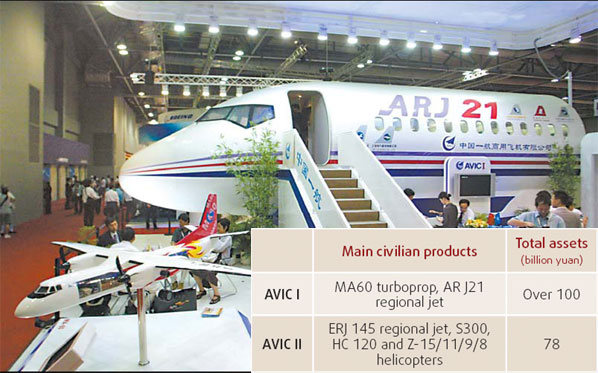Race is on to get plane project off the ground

This year could be a pivotal one for China's large commercial aircraft manufacturers.
The country plans to kick off the design process of a homegrown large commercial plane in the 11th Five-Year Plan period (2006-10) that's expected to take off by 2020.
China is racing against the clock to pool the country's civil aviation manufacturing resources to realize this ambitious dream. China Aviation Industry Corp I (AVIC I) and AVIC II, the country's two leading aviation manufacturers, are likely to be restructured and consolidated.
One possibility is to consolidate the two companies' commercial aircraft manufacturing businesses and establish a new firm, said an official from AVIC II on condition of anonymity.
The State Commission of Science, Technology and Industry for National Defense is working on the restructuring plan, which will need approval from the State Council and the National People's Congress. Details of the restructuring and consolidation are expected to be released in March.
The country's ambitious plan to develop its own large commercial airplanes is the major driving force behind the consolidation move, the official said.
He said the new company would become a shareholder in the joint-stock company, responsible for the large commercial aircraft project.
Liang Zhenhe, vice-president of AVIC II, told China Daily in mid-December that a joint-stock company would be established in March. Its shareholders are likely to include AVIC I, AVIC II, State-owned investment companies and Chinese airlines.
"This project, which requires investment of tens of billions of yuan, must give full play to the initiatives of both central and local authorities. It also needs to stimulate the enthusiasm of Chinese airlines because they will be the end users," Liang said.
The aircraft will be assembled in Shanghai, with the nose, fuselage, wings and tail sections manufactured in other provinces.
"The new joint venture company would be responsible for assembling the large aircraft, with the components manufactured in existing companies controlled by AVIC I and AVIC II," the unnamed AVIC II official said.
AVIC I and AVIC II are two large State-owned industry groups reporting directly to the central government.
AVIC I manufactures the ARJ21, China's indigenously developed regional jet with 70-100 seats, and the 50-seater turboprop MA60. AVIC II is the country's only manufacturer of military and commercial helicopters. It also produces the 50-seater ERJ 145 regional jet in partnership with Brazilian plane maker Embraer.
Both companies have been supplying components to Boeing and Airbus. They are also involved in making non-aviation products such as auto components and motorcycles.
The two companies were set up in 1999 in an industry overhaul that split the former China Aviation Industry Corp into the two main blocs.
Strategic move
After its first large passenger plane development program "Y-10" was abandoned in the 1980s, China decided to produce a passenger jet with at least 150 seats to challenge the domination of Boeing and Airbus in the country's fast-growing aviation market.
The 50-year history of the Chinese aviation industry has helped established a foundation for developing large aircraft. But a more important driving force for the project is the huge market potential for aircraft in China.
The country will remain the largest commercial aircraft market outside the United States in the next 20 years, according to Boeing.
The US aircraft maker forecasts China will need about 3,400 new airplanes, worth $340 billion, over the next two decades, and the country's fleet will nearly quadruple to 4,460 by 2026.
AVIC I has similarly forecast that the country would need an additional 3,365 airplanes by 2026.
Large airplanes will account for over 80 percent of the extra demand for aircraft. Large airplanes usually refer to trunk liners with more than 150 seats and cargo planes with a payload of more than 100 tons. They are the most widely adopted aircraft in civil aviation.
There have been mounting calls from the public for early implementation of the large plane project to ensure China meets surging demand for air travel with its own planes.
Advocates of the large plane project said it is also expected to play a key role in promoting the nation's economy and upgrading industrial technologies as large aircraft production is a highly sophisticated and advanced industry, which will have an enormous "pulling" effect on industries such as electronics, machinery, chemicals and metallurgy.
The State Council, the cabinet, approved the project in February 2007 and set a timetable for the program: the aircraft is expected to take off by 2020. The government has put the project in its 11th Five-Year Plan (2006-10), along with moon exploration and manned spaceflight.
Foreign aviation manufacturers have expressed confidence in China's technical capabilities in producing a large airplane. But they said the biggest challenge China faces would be making the program commercially successful.
"There's no doubt China can build a large aircraft. The challenge is not to build the aircraft, but to sell it and support it," said Laurence Barron, president of Airbus China. "The question is whether it can be a commercial success. It's a tough and very competitive business."
Barron's remarks are echoed by Mauricio Novis Botelho, Embraer's board chairman.
"I don't have any doubt on the technical capabilities of China. But my concern about this announcement is we don't know what aircraft it would be, what market it would serve and what specifications it would have," Botelho said.
"The danger is that aircraft designers are superb designers and they love their creation, but what about the return on investment? What about the market you serve? What about your competitiveness in that market? You must have a very strong and firm view on the market, not on the product. The product must satisfy the market, not the other way around," Botelho said.
(China Daily 01/24/2008 page15)














